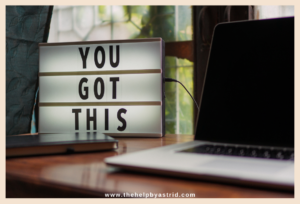
Has working from home increased or decreased your productivity. As a work from home veteran (14 years and counting), we at The Help have come across a sh*t ton of productivity hacks. Some of which are gold standard: stop multitasking, have a routine, take regular breaks, etc. Here are 5 Tips To Power Up Your WFH Productivity. And if you want to know what your productivity style is, find out here (What Is Your Productivity Style?).
I’m sure you already know some of these by heart and now you’re at max prod. However, we have some secret weapons that most of you may not know about. Here are 3 nifty productivity hacks to pull out of your back pocket for days when you have to drag yourself out of bed because you’re “just not feeling it.”
1. One Goal A Day (OGAD!)
On days that you feel not up to acing the work day head-on but need to get things done, this tip might just get you through. Set yourself a priority for the day. This means having one goal for one day. If you have a list of running apps (that’s what I call unfinished tasks that take time to plow through – e.g. e-book writing) set that aside and work on it when you’re in the right mind set. For slow days, identify the tasks that you can check off quite easily but still feel like you’ve accomplished something meaningful for the day. Let’s take e-book writing as an example. You might set yourself this goal for the day: research reference materials for chapter 3. This task is pretty easy to complete but has a great impact on your ultimate goal of writing the e-book. Don’t fall into the trap of doing “busy work.”
2. Short Bursts of Work
An activity can only hold an adult person’s attention for short bursts of time – approx 10- 20 mins. That means an hour is too long for anyone to stay attentive and focused. This is why short bursts of work make perfect sense. That logic has given birth to the Pomodoro Technique which advises working in 25 minute intervals with 5 min breaks in between. It’s one of the most popular productivity hacks out there. Others are the Get Things Done or GTD method and the quirkily named Eat That Frog method.
3. Decompress
One of the challenges of any digital worker is not being able to turn off work. We now have emails, SMS, instant messaging, project management systems, team trackers, etc. – million and one ways to keep track of work. It’s always there, always available to be checked on. The best way to increase your productivity is to rest and recover after a hard day’s work. And you can’t do that if you’re ON all the time. So unplug, relax, decompress, and get ready for another day.
What is your favorite productivity secret weapon? Share them with us in the comments. Remember to work smart and be a blessing to someone today. Stay safe and healthy!
Written by Jaie O. TheHelp



